IAC News
IAC News No.33, July 2015
International Activities Center July. 1, 2015 IAC News No.33
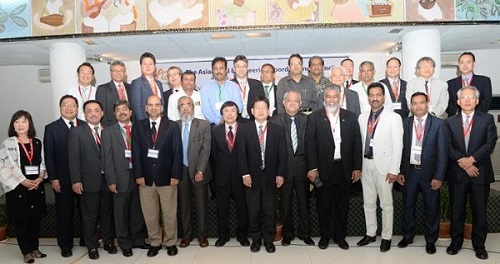
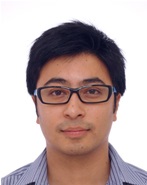
Justin SHRESTHA
Hokkaido University
My student-life, study and impression about Japanese Civil Engineering
I was born and raised in Patan which is one of the major cities of Nepal known for its rich cultural heritage. My interest in the civil engineering started during my undergraduate studies which later became more specific towards the field of structural engineering. Japanese universities being the frontiers in the field, I joined the Masters course in English Engineering Education (e3) program at Hokkaido University. In two years of time, I developed solid background and deep interest in the research area with tremendous support from Prof. Tamon Ueda. His motivation highly encouraged me to continue to the PhD and now I am almost approaching at the end of my student life. When I look back those past years, I really find my journey wonderful with a great learning experiences obtained at different stages of life.
As the part of the course-work, I took several interesting courses related to the field of material science, architectural and structural engineering such as, urban planning, building construction technologies, infrastructure maintenance engineering, construction management, where I was introduced to the latest developments in the field of civil engineering including the evolution of construction industry in Japan. I also got several opportunities to visit construction and maintenance sites of tunnels, bridges, buildings, highways, nuclear power plant etc. as a field visit for the course-work and laboratory technical trips. Through those practical learning experiences, I was able to further enhance my understanding on the subject matters and obtained a general idea on the Japanese civil engineering field. I was highly impressed by Japanese approach of project management using automation and integration of latest technologies and innovations to the practical applications. The quality and standards of work along with the safety requirements set by the Japanese construction industry is unmatched. Due to such reasons, I have developed strong interest to work in Japanese companies after my graduation.
For my PhD studies, I am currently doing research on durability of bond interfaces between concrete and fiber reinforced polymer (FRP) in different environmental conditions. As we all know, rapid ageing of civil infrastructures is one of the most common problems all around the world which can hinder the safety and serviceability of the structures. Therefore, understanding these environmental related deterioration mechanisms help us increase and predict the service life of the structures. I have published my key findings as several scientific articles and also presented my work in front of other researchers in domestic and international conferences. From my perspective, Japan is making huge investments in research and development of the innovative products, technologies, standard codes and guidelines in the several aspects of civil engineering which is paying-off by being the one of the pioneers in the field. In addition, the collaborative research between the universities and industries are also truly remarkable step in bringing out the latest innovations in the market.
Apart from the studies, I have collected several great memories of travelling around different places in Japan. Even though I loved most of the places, Biei, Hakodate, Noboribetsu, Shiretoko and Nara are some of my favorites in the list. I am not a great fan of winter and snow, but occasionally I enjoy going to ski trip with my friends too. If I leave Japan, one thing I would truly miss is its famous hot springs. I have visited several hot springs around the Hokkaido and highly recommend to everyone. In those years, I have made lots of international and Japanese friends by getting associated with some students’ organizations within Hokudai where we together organize different social, educational, professional development events throughout the year. Not only I have found many good friends, but also developed a strong social network of different academic disciplines. I have few more months remaining as a student which I would like to fully utilize by continuing the learning process.
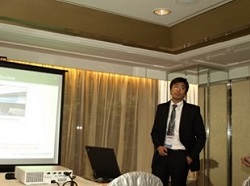
Presenting my paper during an international conference (PLSE 2012) in Hong Kong
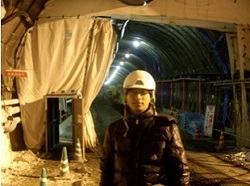
Tunnel construction site visit
Report on ASCE’s Annual Conference in Panama : Mr. Akira Aoyama and 100th Anniversary of the Opening of Panama Canal
JSCE IAC US Group held the meeting to report the American Society of Civil Engineers’ annual conference held in Panama in October 2014 at the auditorium in the JSCE HQ on April 2 2015. In that meeting, the US Group talked about that annual conference, showed the DVD on the civil engineer Akira Aoyama who worked on the Panama Canal construction 100 year ago and had a special lecture with Emeritus Prof. Yutaka Takahashi as a speaker.
Also the US Group displayed Akira Aoyama’s photos, drawings and memorabilia on tables and stands which were placed around that auditorium so that the audience could see them and imagine the environment in which Akira worked on the Panama Canal construction. Akira’s handwritten drawings were very clean and sophisticated so that the audience seemed not to believe that those had been produced by human hands.
Prof. Masahiko Isobe the JSCE President delivered an opening speech, followed by the US Group members’ reports on the ASCE’s annual conference and the Mini General Session which the ASCE had set for the US Group to make a presentation, and a field trip to the Panama Canal. The US Group told that Prof. Isobe discussed Akira’s achievements and contribution to the construction of the Panama Canal and later his contribution to the development of infrastructure in Japan at the Mini General Session. That group referred to the responses of the audience who had been moved by the Japanese civil engineer who had traveled alone to Panama and joined the construction, following his dreams and motto “Do your best to leave the world better than you found it,” and who had appreciated Prof. Isobe’s discussion, making the commnent “a beautiful presentation” with a big hand.
Then, Emeritus Prof. Yutaka Takahashi of the University of Tokyo took a podium and delivered a speech. He portrayed Akira Aoyama as a civil engineer with anecdotes explaining the Japanese society in those days, including his meeting with Mr. Aoyama. His talk was very informative and interesting so that it held the audience’s attention all through.
After his talk, the US group played the DVD on Akira Aoyama’s Achievements on Panama Canal Project which had been shown along with the presentation of Prof. Isobe at the Mini General Session. Many of members of audience made comments and ask questions to the speakers at the Q & A session set at the end of the meeting. When Dr. Ohnishi closed the meeting, it was about 30 minutes after the scheduled ending time.
【Mr. Hisanari Ushirooka member of the IAC Information Networking Group】
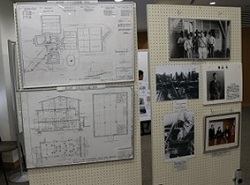
Akira’s handwritten drawings and his photo in Panama
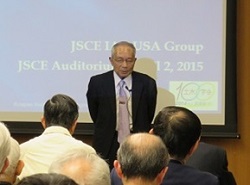
Emeritus Prof. Yutaka Takahashi describes Akira Aoyama with anecdotes.
Report on Seminar on “Present and future road infrastructure maintenance in Vietnam and Japan”
The seminar on “Present and Future Road Infrastructure Maintenance in Vietnam and Japan” was held National University of Civil Engineering (NUCE) on March 17, 2015, co-organized by NUCE, the University of Tokyo, Hokkaido University and Japan Society of Civil engineers (JSCE). The CJV staff members and those co-organizers made a significant contribution to the success of seminar. Remarkable results and photos were recorded at this Seminar.
There were 150 participants from Ministry of Transport (MOT), Ministry of Construction (MOC), agencies, PMU, Japanese and Vietnamese construction companies, prestigious universities in Japan and Viet Nam, international and Vietnamese leading experts in the field of road maintenance.
Speaking at the seminar, Assoc. Prof. Pham Duy Hoa, Rector of NUCE noted that Japan is one of the most important partners of Viet Nam in the field of transport infrastructure development. Numerous large and important projects have been implemented efficiently with the help and cooperation of Japan. In recent years, NUCE cooperated with Japanese partners in the exchange of experience, advanced construction technologies applying in Viet Nam. So far, Japan has been involved many big projects of civil construction, infrastructure and urban transport in Viet Nam. This seminar is a scientific forum for Vietnamese and Japanese experts to exchange knowledge and experience on the involved topic.
According to Prof. Hiroshi Yokota, University of Hokkaido, Japan is honored to share its experience in the field of road maintenance system for Viet Nam as well as other countries. In the coming time, Japan will focus on Viet Nam via SIP project and he also hopes to strengthen the cooperation between Vietnam and Japan.
According to Assoc. Prof. Kohei Nagai the University of Tokyo, this seminar is the 2nd SIP (Cross-ministerial Strategic Innovation Program) international seminar on Infrastructure Asset Management funded by Cabinet Office of Japan. Title of the research project is a comprehensive research on development of road infrastructure management cycle and its application in Japan and abroad. The project term is from October 2014 to March 2019.
The presentations were delivered on the following topics:
1)Standard specifications for maintenance and repair of concrete structures;
2)Deteriorations of road infrastructures in Japan;
3)Vietnam Road management;
4)Education program for maintenance expert in Gifu;
5)Durable repair of concrete structures considering re-deterioration;
6)Opportunities for enhancing management and maintenance of road infrastructure in Vietnam;
7)Overview of bridge maintenance of NEXCO;
8)Standards for inspection maintenance and repair of concrete structures.
At the seminar, there were lots of discussion and exchange between speakers and attendees for better understanding of the raised topics. Many questions posed by Vietnamese experts were fully responded by Japanese experts.
The Seminar on “Present and future road infrastructure maintenance in Vietnam and Japan” has been successfully organized with good results. It is the prerequisite to create a cooperative network for promoting the research and technology transfer in the field of road inspection, maintenance and repair ensuring the success of SIP project in Viet Nam. The Seminar and its activities were reported on Hanoi Television as well.
Through a number of presented topics, the seminar was a scientific forum for experts from Japan and Vietnam to share their experiences and discuss research proposals to find out suitable solutions for the development of Vietnam's infrastructure.
【Dr. Nguyen Hoang Giang, Director of CJV】
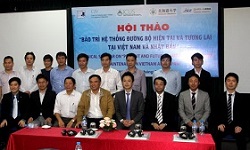 Group photo of the Speakers |
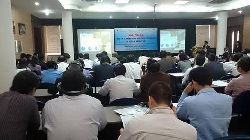 Participants at seminar |
What's Happening
- 2015/7/8-10 EIT Civil Engineering Meeting (Pattaya, Thailand)
- 2015/7/22 IAC Japanese Civil Engineers the Global Leaders Symposium Series No.5 on”Upper Kotmale Hydro Power Project” at the JSCE HQ, Tokyo http://committees.jsce.or.jp/kokusai/node/80 (Japanese only)
Updates
- The summary of feature articles in the JSCE Magazine is available on the JSCE website.
http://www.jsce-int.org/pub/magazine - Concrete Committee International Newsletter No. 41
http://www.jsce.or.jp/committee/concrete/e/newsletter/Newsletter.htm - Journal of JSCE
The Journal of JSCE is the collection of research papers which can be viewed on the JSCE website.
https://www.jstage.jst.go.jp/browse/journalofjsce - JSCE 100th Anniversary Postal Stamp was released in September, 2014.
http://jsce100.com/node/250 (Japanese Only) - European Council of Civil Engineers (ECCE) has released the 2nd
book in ECCE Book Project, ”Footbridges-Small is beautiful.” 17 footbridges are contributed from JSCE:
http://www.ecceengineers.eu/
IAC News Subscription
The IAC News is one of the communication tools to share information and ideas with the members. We would like to invite you, your friends and colleagues to join the communication and to subscribe the IAC News. Please register online: (http://www.jsce-int.org/pub/registration/non-international_students). We look forward to meeting you.
Editor's postscript
The 2020 Tokyo Olympic and Paralympic Games hit the headlines very often in these days. Preparations for those games and plans of sports venues are underway at the initiative of the Olympic Organizing Committee and the Tokyo Metropolitan Government. However, the total cost to construct the New National Stadium, the main venue of the games, will exceed the originally planned budget 162.5 billion yen by a large margin. That casts on an ominous shadow over further communication between the Minister of Education, Culture, Sports, Science and Technology and the Governor of Tokyo Metropolitan Government. The new national stadium is expected to cost several times as much as the previous Olympic stadium did. The government should explain to the people in more plain terms as to the meanings, appropriateness of building that huge stadium, and the uses of Olympic venues after the games. (H.I.)
